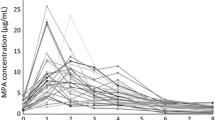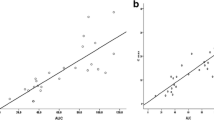Abstract
In this paper, we report the pharmacokinetics changes observed in seven children with steroid-resistant nephrotic syndrome (SRNS). They received cyclosporine A (CsA) microemulsion 6 mg/kg/day and, one week later, they were admitted to perform a 12-h pharmacokinetic profile with eight time sample points. The pharmacokinetic profile was repeated at 24 weeks of treatment, when all patients achieved remission. Blood concentration against time curves were constructed for each patient at weeks 1 and 24 of CsA treatment. Peak concentrations (C max) and the time needed to reach peak concentrations (t max) were directly determined from these plots. The area under the curve (AUC) was estimated by the trapezoidal rule. There was a statistically significant difference of the AUC, trough levels, and t max between weeks 1 and 24, with a decrease of AUC from 5,211 ng*h/ml in week 1 to 3,289 ng*h/ml in week 24, the trough levels decreased from 157 ng/ml to 96 ng/ml, and the t max decreased from 1.85 h to 1.00 h. The higher CsA bioavailability during the nephrotic state has to be considered when managing patients, since the target AUC cannot be the same throughout the treatment.



Similar content being viewed by others
References
(1981) The primary nephrotic syndrome in children. Identification of patients with minimal change nephrotic syndrome from initial response to prednisone. A report of the International Study of Kidney Disease in Children. J Pediatr 98(4):561–564
Seikaly M, Ho PL, Emmett L, Tejani A (2001) The 12th Annual Report of the North American Pediatric Renal Transplant Cooperative Study: renal transplantation from 1987 through 1998. Pediatr Transplant 5(3):215–231
Desassis JF, Raats CJ, Bakker MA, van den Born J, Berden JH (1997) Antiproteinuric effect of ciclosporin A in adriamycin nephropathy in rats. Nephron 75(3):336–341
Gregory MJ, Smoyer WE, Sedman A, Kershaw DB, Valentini RP, Johnson K, Bunchman TE (1996) Long-term cyclosporine therapy for pediatric nephrotic syndrome: a clinical and histologic analysis. J Am Soc Nephrol 7(4):543–549
Niaudet P, Broyer M, Habib R (1991) Treatment of idiopathic nephrotic syndrome with cyclosporin A in children. Clin Nephrol 35(Suppl 1):S31–S36
(1991) Safety and tolerability of cyclosporin A (Sandimmun) in idiopathic nephrotic syndrome. Collaborative Study Group of Sandimmun in Nephrotic Syndrome. Clin Nephrol 35(Suppl 1):S48–S60
Niaudet P, Fuchshuber A, Gagnadoux MF, Habib R, Broyer M (1997) Cyclosporine in the therapy of steroid-resistant idiopathic nephrotic syndrome. Kidney Int 58(Suppl):S85–S90
Lieberman KV, Tejani A (1996) A randomized double-blind placebo-controlled trial of cyclosporine in steroid-resistant idiopathic focal segmental glomerulosclerosis in children. J Am Soc Nephrol 7(1):56–63
Ponticelli C, Rizzoni G, Edefonti A, Altieri P, Rivolta E, Rinaldi S, Ghio L, Lusvarghi E, Gusmano R, Locatelli F, Pasquali S, Castellani A, Casa-Alberighi O (1993) A randomized trial of cyclosporine in steroid-resistant idiopathic nephrotic syndrome. Kidney Int 43(6):1377–1384
Seikaly MG, Prashner H, Nolde-Hurlbert B, Browne R (2000) Long-term clinical and pathological effects of cyclosporin in children with nephrosis. Pediatr Nephrol 14(3):214–217
Cattran DC, Appel GB, Hebert LA, Hunsicker LG, Pohl MA, Hoy WE, Maxwell DR, Kunis CL (1999) A randomized trial of cyclosporine in patients with steroid-resistant focal segmental glomerulosclerosis. North America Nephrotic Syndrome Study Group. Kidney Int 56(6):2220–2226
Meyrier A, Noel LH, Auriche P, Callard P (1994) Long-term renal tolerance of cyclosporin A treatment in adult idiopathic nephrotic syndrome. Collaborative Group of the Societe de Nephrologie. Kidney Int 45(5):1446–1456
Sairam VK, Kalia A, Rajaraman S, Travis LB (2002) Secondary resistance to cyclosporin A in children with nephrotic syndrome. Pediatr Nephrol 17(10):842–846
Singh A, Tejani C, Tejani A (1999) One-center experience with cyclosporine in refractory nephrotic syndrome in children. Pediatr Nephrol 13(1):26–32
Raafat RH, Kalia A, Travis LB, Diven SC (2004) High-dose oral cyclosporin therapy for recurrent focal segmental glomerulosclerosis in children. Am J Kidney Dis 44(1):50–56
Iyengar A, Karthik S, Kumar A, Biswas S, Phadke K (2006) Cyclosporine in steroid dependent and resistant childhood nephrotic syndrome. Indian Pediatr 43(1):14–19
Iijima K, Hamahira K, Tanaka R, Kobayashi A, Nozu K, Nakamura H, Yoshikawa N (2002) Risk factors for cyclosporine-induced tubulointerstitial lesions in children with minimal change nephrotic syndrome. Kidney Int 61(5):1801–1805
Tanaka R, Yoshikawa N, Kitano Y, Ito H, Nakamura H (1993) Long-term ciclosporin treatment in children with steroid-dependent nephrotic syndrome. Pediatr Nephrol 7(3):249–252
Chishti AS, Sorof JM, Brewer ED, Kale AS (2001) Long-term treatment of focal segmental glomerulosclerosis in children with cyclosporine given as a single daily dose. Am J Kidney Dis 38(4):754–760
Hoyer PF (1998) Cyclosporin A (Neoral) in pediatric organ transplantation. Neoral Pediatric Study Group. Pediatr Transplant 2(1):35–39
Gugler R, Shoeman DW, Huffman DH, Cohlmia JB, Azarnoff DL (1975) Pharmacokinetics of drugs in patients with the nephrotic syndrome. J Clin Invest 55(6):1182–1189
Vrhovac B, Sarapa N, Bakran I, Huic M, Macolic-Sarinic V, Francetic I, Wolf-Coporda A, Plavsic F (1995) Pharmacokinetic changes in patients with oedema. Clin Pharmacokinet 28(5):405–418
von Ahsen N, Helmhold M, Schutz E, Eisenhauer T, Armstrong VW, Oellerich M (1997) Cyclosporin A trough levels correlate with serum lipoproteins and apolipoproteins: implications for therapeutic drug monitoring of cyclosporin A. Ther Drug Monit 19(2):140–145
Akhlaghi F, Trull AK (2002) Distribution of cyclosporin in organ transplant recipients. Clin Pharmacokinet 41(9):615–637
Medeiros M, Perez-Urizar J, Pedraza-Chaverri J, Castañeda-Hernández G (2001) Pharmacokinetics of cyclosporin in rats with experimental nephrotic syndrome. In: Nephrol JAS (ed) p A3568
Rinaldi S, Sesto A, Barsotti P, Faraggiana T, Sera F, Rizzoni G (2005) Cyclosporine therapy monitored with abbreviated area under curve in nephrotic syndrome. Pediatr Nephrol 20(1):25–29
Nozu K, Iijima K, Sakaeda T, Okumura K, Nakanishi K, Yoshikawa N, Honda M, Ikeda M, Matsuo M (2005) Cyclosporin A absorption profiles in children with nephrotic syndrome. Pediatr Nephrol 20(7):910–913
Filler G (2005) How should microemulsified Cyclosporine A (Neoral) therapy in patients with nephrotic syndrome be monitored? Nephrol Dial Transplant 20(6):1032–1034
Schwartz GJ, Feld LG, Langford DJ (1984) A simple estimate of glomerular filtration rate in full-term infants during the first year of life. J Pediatr 104(6):849–854
Martin JE, Daoud AJ, Schroeder TJ, First MR (1999) The clinical and economic potential of cyclosporin drug interactions. Pharmacoeconomics 15(4):317–337
Niaudet P, Reigneau O, Humbert H (2001) A pharmacokinetic study of Neoral in childhood steroid-dependent nephrotic syndrome. Pediatr Nephrol 16(2):154–155
Niaudet P, Habib R (1994) Cyclosporine in the treatment of idiopathic nephrosis. J Am Soc Nephrol 5(4):1049–1056
Medeiros M, Gomez AC, Urizar JP, Campos-Sepulveda AE, Saldana IM, Ramirez LE, Romero NB, Velasquez JL, Castañeda-Hernández G, Munoz R (1998) Bioavailability of two oral formulations of cyclosporin A in uremic children before renal transplantation. Pediatr Transplant 2(2):145–149
Cooney GF, Habucky K, Hoppu K (1997) Cyclosporin pharmacokinetics in paediatric transplant recipients. Clin Pharmacokinet 32(6):481–495
Briggs WA, Gao ZH, Xing JJ, Scheel PJ, Gimenez LF, Samaniego MD, Choi MJ, Burdick JF (1997) Suppression of dialysis patients’ lymphocyte IL-2R expression by glucocorticoids and cyclosporine. Cytokine 9(8):624–628
Resch K, Szamel M (1997) Molecular mechanisms of the immunosuppressive action of cyclosporin A. Int J Immunopharmacol 19(9–10):579–585
Awni WM, Kasiske BL, Heim-Duthoy K, Rao KV (1989) Long-term cyclosporine pharmacokinetic changes in renal transplant recipients: effects of binding and metabolism. Clin Pharmacol Ther 45(1):41–48
Kovarik JM, Mueller EA, Richard F, Niese D, Halloran PF, Jeffery J, Paul LC, Keown PA (1996) Evidence for earlier stabilization of cyclosporine pharmacokinetics in de novo renal transplant patients receiving a microemulsion formulation. Transplantation 62(6):759–763
Sgoutas D, MacMahon W, Love A, Jerkunica I (1986) Interaction of cyclosporin A with human lipoproteins. J Pharm Pharmacol 38(8):583–588
Ingulli E, Tejani A (1992) Severe hypercholesterolemia inhibits cyclosporin A efficacy in a dose-dependent manner in children with nephrotic syndrome. J Am Soc Nephrol 3(2):254–259
de Groen PC, Wiesner RH, Krom RA (1988) Cyclosporine A-induced side effects related to a low total serum cholesterol level: an indication for a free cyclosporine A assay? Transplant Proc 20(2 Suppl 2):374–376
Okuda T, Oh-i T (2002) Cyclosporin A pharmacokinetics in a patient with psoriasis and obesity, presenting with high levels of low-density [correction for destiny] lipoprotein. Eur J Clin Pharmacol 58(4):299–300
Hirano T, Akashi T, Keira T, Oka K, Ihoya N, Yoshida M (2000) Clinical impact of cyclosporine cellular pharmacodynamics in minimal change nephrotic syndrome. Clin Pharmacol Ther 68(5):532–540
Author information
Authors and Affiliations
Corresponding author
Rights and permissions
About this article
Cite this article
Medeiros, M., Pérez-Urizar, J., Mejía-Gaviria, N. et al. Decreased cyclosporine exposure during the remission of nephrotic syndrome. Pediatr Nephrol 22, 84–90 (2007). https://doi.org/10.1007/s00467-006-0300-6
Received:
Revised:
Accepted:
Published:
Issue Date:
DOI: https://doi.org/10.1007/s00467-006-0300-6




